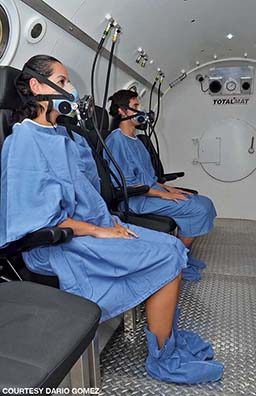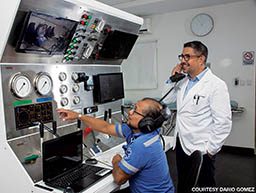My journey to becoming a divemaster has been a complicated one. In May 2017 I quit my wonderful job at Ripley’s Aquarium of Canada, packed my bags and moved to Cozumel, Mexico, to complete my divemaster and Instructor Development Course (IDC) training. I wanted to make diving my life, not just my job.
I have been diving since 2015 and have completed almost 100 dives, including liveaboard trips and countless dives in a variety of conditions and at various depths. There were even dives where I rushed to the aid of a panicked diver underwater and still surfaced safely. I had never experienced any issues.

On the third day of my divemaster course, we did a casual, fun morning dive at Santa Rosa Wall and the Felipe Xicoténcatl (C53) shipwreck in Cozumel. During the first dive at Santa Rosa Wall, I was buddied up with a dive instructor. We dived a maximum depth of 107 feet without exceeding our no-decompression limit. It was one of the most relaxing dives I have ever done, as the current gently carried us along. The dive lasted for 60 minutes, and I completed an extra-long safety stop, hoping to catch a glimpse of a shark swimming by.
When we returned to the boat and headed toward our next dive site, I started feeling unusually tired, but I disregarded it. Instead, I loaded up on water before the next dive, assuming I was just dehydrated.
More than an hour later, we were ready to jump back in the water. During our descent along the mooring line, I had a brief moment in which I felt very uncomfortable and wondered whether I was experiencing nitrogen narcosis (my air was 21 percent oxygen and 79 percent nitrogen). The moment passed almost immediately though, so I readjusted my mask; maybe it was too tight, and that was the problem, I thought. During the dive, we reached a maximum depth of 70 feet, but I spent most of my time around 40 feet, exploring the top of the wreck. Again, this dive went smoothly, and we completed a long safety stop at 15 feet with a very slow ascent.
After we surfaced, boarded the boat and started heading back to land, I began to feel an itching sensation in my right arm, assuming it was just those pesky mosquitoes. Unfortunately, the itching quickly intensified into a burning feeling. By the time we reached the docks, it had spread from my arm to the rest of my body, and I found myself suffering from severe, painful burning across my body. I then quickly developed a mottled rash that spread across my arms, back, chest, stomach and legs. I notified the dive instructors, and they sent me to the International Hospital.

I arrived at the hospital less than an hour after my last dive. Meanwhile, the coloration of my rash had deepened significantly to dark purple and blue around my chest and heart. My body looked bruised all over. During my initial meeting with the doctor, I was extremely disoriented and could not keep my thoughts straight. I kept forgetting the date and time and couldn’t describe my last two dives, even though I was staring right at my dive computer. My eyesight completely blurred, and I struggled to keep my balance during the examination. The severe burning across my body was now accompanied by significant pain in my chest and abdomen. The doctor diagnosed me with Type 2 neurological decompression sickness (DCS).
I was rushed into a hyperbaric chamber for five and a half hours. Over the next seven days I underwent six U.S. Navy Treatment Table 6 hyperbaric chamber treatments. By the seventh day, my last hyperbaric treatment was only three and a half hours long. I appeared to be recovered, with no residual symptoms.
In between the treatments, my doctors ran myriad tests to determine what caused me to get the bends, since nothing abnormal had occurred during my dives. The head of cardiology discovered that I had an atrial septal defect (ASD), or an opening in the wall that separates the top two chambers of the heart, and an alarming amount of nitrogen bubbles in my heart, vena cava, jugular veins, subclavian veins and liver. Although I was finished with the hyperbaric treatments, my journey back to diving was nowhere near over. They informed me that if I wanted to dive again, I needed to return to Canada for heart surgery. I was completely heartbroken (pun fully intended).
In November 2017 I underwent a heart procedure to close a 4.5 cm (1.8 inch) hole in my heart. After six months of recovery, I had my final checkup with the surgeon and a dive physician. They ran a series of tests to see if my heart had healed completely and if I was fit to dive again. Fortunately, my heart had recovered, and diving within recreational limits is still possible for me. From now on, I will be very conservative with my diving.
A year after my incident, I was cleared to dive again, and within a day I had purchased a flight back to Cozumel. My first dive after my terrifying and emotional journey was mentally taxing. I didn’t expect to experience fear and have flashbacks from the year before; however, I persevered. I have now completed my enriched-air certification and will most likely dive nitrox from now on, which will give me greater peace of mind until I am fully comfortable underwater. I will also continue to carry DAN’s dive accident insurance, for which I am grateful.
With each day and additional dive, I am slowly regaining my confidence and learning to trust my body again. I am still here in Mexico, diving every day and loving every minute of it.
| © Alert Diver — Q3 2018 |
|---|
| © Alert Diver — Q3 2018 |